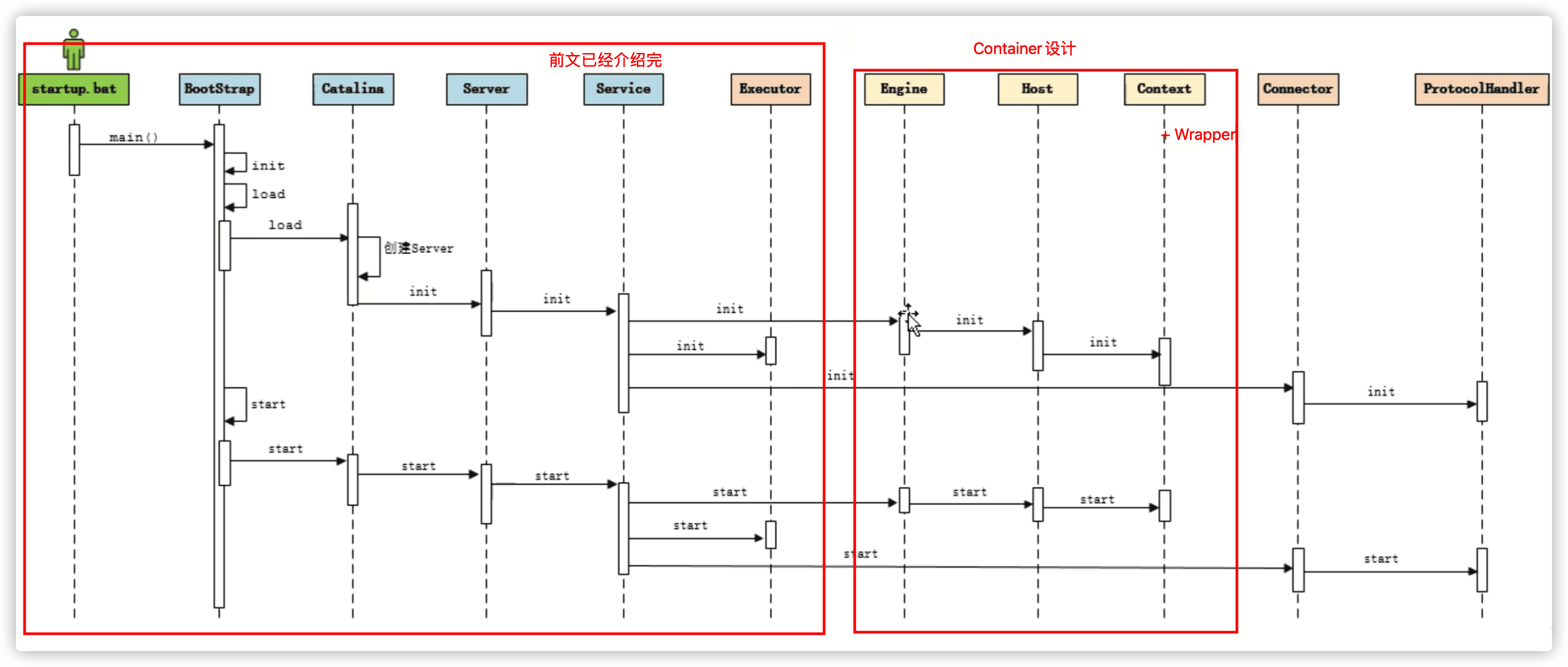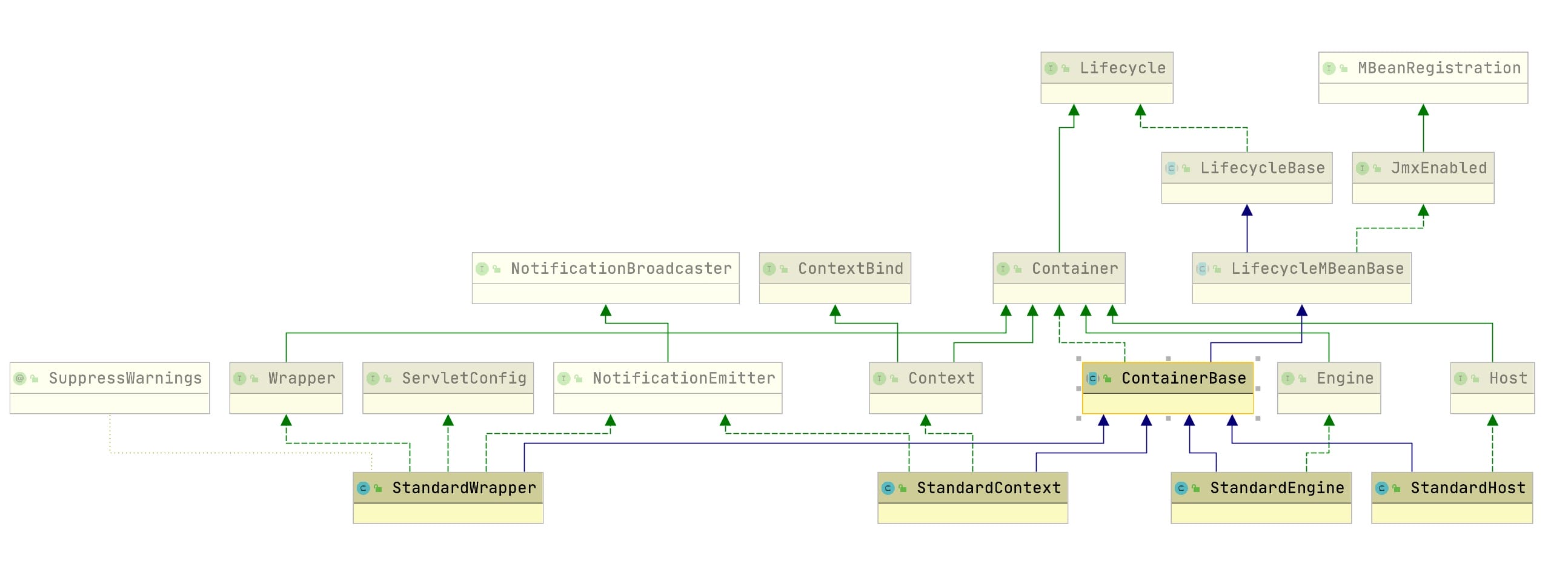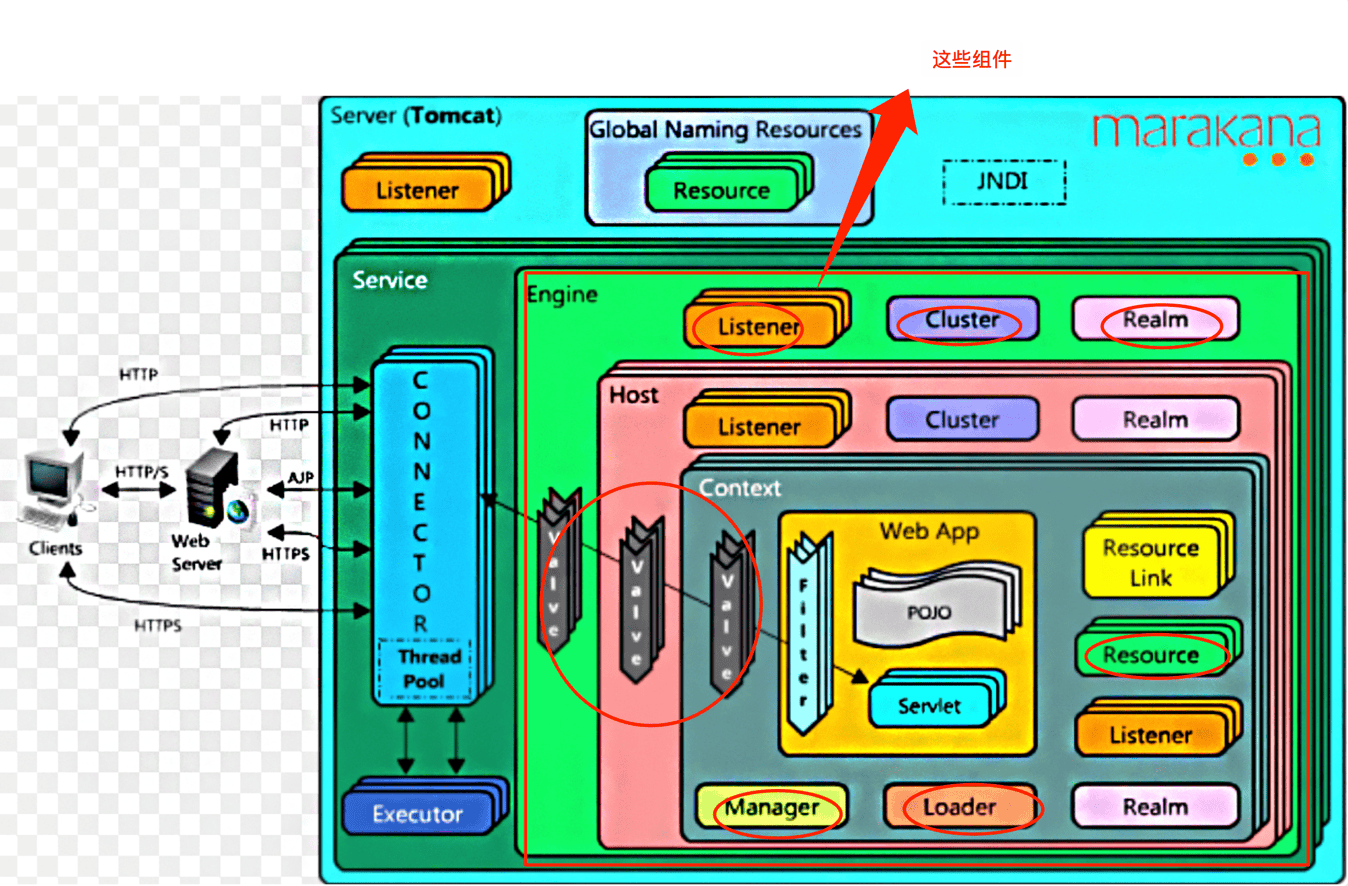Tomcat - Request请求处理: Container设计
Tomcat - Request请求处理: Container设计
提示
在理解了Server,Service和Executor后,我们可以进入Request处理环节了。我们知道客户端是可以发起多个请求的,Tomcat也是可以支持多个webapp的,有多个上下文,且一个webapp中可以有多个Servlet...等等,那么Tomcat是如何设计组件来支撑请求处理的呢?本节文将介绍Tomcat的Container设计。
- Tomcat - Request请求处理: Container设计
- 内容引入
- 理解思路
- Container的设计
- Container的层次结构方法
- Container事件监听相关方法
- Container功能支撑方法
- Container基本实现:ContainerBase
- Logger
- Cluster
- Realm
- name等属性
- child相关
- Lifecycle的模板方法
内容引入
这里一定把握住我们上下文之间的衔接,这是我们整个系列理解Tomcat的主线。

理解思路
- 为什么我们说上面的是Container呢?我们看下几个Container之间的关系 :

从上图上,我们也可以看出Container顶层也是基于Lifecycle的组件设计的。
- 在设计Container组件层次组件时,上述4个组件分别做什么的呢?为什么要四种组件呢?
如下是Container接口类的相关注释
* <li><b>Engine</b> - Representation of the entire Catalina servlet engine,
* most likely containing one or more subcontainers that are either Host
* or Context implementations, or other custom groups.
* <li><b>Host</b> - Representation of a virtual host containing a number
* of Contexts.
* <li><b>Context</b> - Representation of a single ServletContext, which will
* typically contain one or more Wrappers for the supported servlets.
* <li><b>Wrapper</b> - Representation of an individual servlet definition
* (which may support multiple servlet instances if the servlet itself
* implements SingleThreadModel).
* </ul>
Engine - 表示整个catalina的servlet引擎,多数情况下包含 一个或多个 子容器,这些子容器要么是Host,要么是Context实现,或者是其他自定义组。
Host - 表示包含多个Context的虚拟主机的。
Context — 表示一个ServletContext,表示一个webapp,它通常包含一个或多个wrapper。
Wrapper - 表示一个servlet定义的(如果servlet本身实现了SingleThreadModel,则可能支持多个servlet实例)。
- 结合整体的框架图中上述组件部分,我们看下包含了什么 ?

很明显,除了四个组件的嵌套关系,Container中还包含了Realm,Cluster,Listeners, Pipleline等支持组件。
这一点,还可以通过相关注释可以看出:
**Loader** - Class loader to use for integrating new Java classes for this Container into the JVM in which Catalina is running.
**Logger** - Implementation of the log() method signatures of the ServletContext interface.
**Manager** - Manager for the pool of Sessions associated with this Container.
**Realm** - Read-only interface to a security domain, for authenticating user identities and their corresponding roles.
**Resources** - JNDI directory context enabling access to static resources, enabling custom linkages to existing server components when Catalina is embedded in a larger server.
Container的设计
这container应该包含哪些接口呢?如果你看源代码它包含二十多个接口,这里理解的时候一定要分组去理解。
Container的层次结构方法
查找父容器的方法:
/**
* Get the parent container.
*
* @return Return the Container for which this Container is a child, if
* there is one. If there is no defined parent, return
* <code>null</code>.
*/
public Container getParent();
/**
* Set the parent Container to which this Container is being added as a
* child. This Container may refuse to become attached to the specified
* Container by throwing an exception.
*
* @param container Container to which this Container is being added
* as a child
*
* @exception IllegalArgumentException if this Container refuses to become
* attached to the specified Container
*/
public void setParent(Container container);
由于Engine显然上层是Service,所以里面加了一个getService的方法
/**
* Return the Service to which this container belongs.
* @param container The container to start from
* @return the Service, or null if not found
*/
public static Service getService(Container container) {
while (container != null && !(container instanceof Engine)) {
container = container.getParent();
}
if (container == null) {
return null;
}
return ((Engine) container).getService();
}
类比树接口,有Parent方法,那肯定也child方法:
/**
* Add a new child Container to those associated with this Container,
* if supported. Prior to adding this Container to the set of children,
* the child's <code>setParent()</code> method must be called, with this
* Container as an argument. This method may thrown an
* <code>IllegalArgumentException</code> if this Container chooses not
* to be attached to the specified Container, in which case it is not added
*
* @param child New child Container to be added
*
* @exception IllegalArgumentException if this exception is thrown by
* the <code>setParent()</code> method of the child Container
* @exception IllegalArgumentException if the new child does not have
* a name unique from that of existing children of this Container
* @exception IllegalStateException if this Container does not support
* child Containers
*/
public void addChild(Container child);
/**
* Obtain the child Containers associated with this Container.
*
* @return An array containing all children of this container. If this
* Container has no children, a zero-length array is returned.
*/
public Container[] findChildren();
/**
* Remove an existing child Container from association with this parent
* Container.
*
* @param child Existing child Container to be removed
*/
public void removeChild(Container child);
Container事件监听相关方法
前文我们也分析过Tomcat的事件监听机制,Container也是一样, 比如如下的ContainerListener
/**
* Add a container event listener to this component.
*
* @param listener The listener to add
*/
public void addContainerListener(ContainerListener listener);
/**
* Obtain the container listeners associated with this Container.
*
* @return An array containing the container listeners associated with this
* Container. If this Container has no registered container
* listeners, a zero-length array is returned.
*/
public ContainerListener[] findContainerListeners();
/**
* Remove a container event listener from this component.
*
* @param listener The listener to remove
*/
public void removeContainerListener(ContainerListener listener);
除了Container级别的,和前文我们理解的一样,还有属性相关的Listener, 显然就增删属性的监听方法
/**
* Remove a property change listener from this component.
*
* @param listener The listener to remove
*/
public void removePropertyChangeListener(PropertyChangeListener listener);
/**
* Add a property change listener to this component.
*
* @param listener The listener to add
*/
public void addPropertyChangeListener(PropertyChangeListener listener);
最后显然还有事件的触发方法
/**
* Notify all container event listeners that a particular event has
* occurred for this Container. The default implementation performs
* this notification synchronously using the calling thread.
*
* @param type Event type
* @param data Event data
*/
public void fireContainerEvent(String type, Object data);
Container功能支撑方法
前面我们知道,Loader, Logger, Manager, Realm, Resources等支撑功能。这里简单看下接口定义,相关基本实现看下节ContainerBase的实现。
- Loader
/**
* Get the parent class loader.
*
* @return the parent class loader for this component. If not set, return
* {@link #getParent()}.{@link #getParentClassLoader()}. If no
* parent has been set, return the system class loader.
*/
public ClassLoader getParentClassLoader();
/**
* Set the parent class loader for this component. For {@link Context}s
* this call is meaningful only <strong>before</strong> a Loader has
* been configured, and the specified value (if non-null) should be
* passed as an argument to the class loader constructor.
*
* @param parent The new parent class loader
*/
public void setParentClassLoader(ClassLoader parent);
- Logger
/**
* Obtain the log to which events for this container should be logged.
*
* @return The Logger with which this Container is associated. If there is
* no associated Logger, return the Logger associated with the
* parent Container (if any); otherwise return <code>null</code>.
*/
public Log getLogger();
/**
* Return the logger name that the container will use.
* @return the abbreviated name of this container for logging messages
*/
public String getLogName();
- Manager
体现在我们之前分析的JMX管理
/**
* Obtain the JMX name for this container.
*
* @return the JMX name associated with this container.
*/
public ObjectName getObjectName();
/**
* Obtain the JMX domain under which this container will be / has been
* registered.
*
* @return The JMX domain name
*/
public String getDomain();
/**
* Calculate the key properties string to be added to an object's
* {@link ObjectName} to indicate that it is associated with this container.
*
* @return A string suitable for appending to the ObjectName
*
*/
public String getMBeanKeyProperties();
/**
* Obtain the number of threads available for starting and stopping any
* children associated with this container. This allows start/stop calls to
* children to be processed in parallel.
*
* @return The currently configured number of threads used to start/stop
* children associated with this container
*/
public int getStartStopThreads();
- Realm
/**
* Obtain the Realm with which this Container is associated.
*
* @return The associated Realm; if there is no associated Realm, the
* Realm associated with the parent Container (if any); otherwise
* return <code>null</code>.
*/
public Realm getRealm();
/**
* Set the Realm with which this Container is associated.
*
* @param realm The newly associated Realm
*/
public void setRealm(Realm realm);
- Cluster
/**
* Get the Cluster for this container.
*
* @return The Cluster with which this Container is associated. If there is
* no associated Cluster, return the Cluster associated with our
* parent Container (if any); otherwise return <code>null</code>.
*/
public Cluster getCluster();
/**
* Set the Cluster with which this Container is associated.
*
* @param cluster the Cluster with which this Container is associated.
*/
public void setCluster(Cluster cluster);
- 其它
/**
* Return a name string (suitable for use by humans) that describes this
* Container. Within the set of child containers belonging to a particular
* parent, Container names must be unique.
*
* @return The human readable name of this container.
*/
public String getName();
/**
* Set a name string (suitable for use by humans) that describes this
* Container. Within the set of child containers belonging to a particular
* parent, Container names must be unique.
*
* @param name New name of this container
*
* @exception IllegalStateException if this Container has already been
* added to the children of a parent Container (after which the name
* may not be changed)
*/
public void setName(String name);
/**
* Sets the number of threads available for starting and stopping any
* children associated with this container. This allows start/stop calls to
* children to be processed in parallel.
* @param startStopThreads The new number of threads to be used
*/
public void setStartStopThreads(int startStopThreads);
/**
* Obtain the location of CATALINA_BASE.
*
* @return The location of CATALINA_BASE.
*/
public File getCatalinaBase();
/**
* Obtain the location of CATALINA_HOME.
*
* @return The location of CATALINA_HOME.
*/
public File getCatalinaHome();
Container基本实现:ContainerBase
就讲讲几个比较核心的
Logger
日志记录器,比较简单,直接看代码
/**
* Return the Logger for this Container.
*/
@Override
public Log getLogger() {
if (logger != null)
return logger;
logger = LogFactory.getLog(getLogName());
return logger;
}
/**
* @return the abbreviated name of this container for logging messages
*/
@Override
public String getLogName() {
if (logName != null) {
return logName;
}
String loggerName = null;
Container current = this;
while (current != null) {
String name = current.getName();
if ((name == null) || (name.equals(""))) {
name = "/";
} else if (name.startsWith("##")) {
name = "/" + name;
}
loggerName = "[" + name + "]"
+ ((loggerName != null) ? ("." + loggerName) : "");
current = current.getParent();
}
logName = ContainerBase.class.getName() + "." + loggerName;
return logName;
}
Cluster
getCluster:读锁,获取子类的cluster,如果没有则返回父类的cluster;getClusterInternal: 读锁,获取子类的clustersetCluster: 写锁,设置container的cluster;由于cluster具备生命周期,所以需要对停止旧的cluster,启动新的cluster;设置成功后,再触发cluster变更事件。
/**
* The cluster with which this Container is associated.
*/
protected Cluster cluster = null;
private final ReadWriteLock clusterLock = new ReentrantReadWriteLock();
/**
* The parent Container to which this Container is a child.
*/
protected Container parent = null;
/**
* Return the Cluster with which this Container is associated. If there is
* no associated Cluster, return the Cluster associated with our parent
* Container (if any); otherwise return <code>null</code>.
*/
@Override
public Cluster getCluster() {
Lock readLock = clusterLock.readLock();
readLock.lock();
try {
if (cluster != null)
return cluster;
if (parent != null)
return parent.getCluster();
return null;
} finally {
readLock.unlock();
}
}
/*
* Provide access to just the cluster component attached to this container.
*/
protected Cluster getClusterInternal() {
Lock readLock = clusterLock.readLock();
readLock.lock();
try {
return cluster;
} finally {
readLock.unlock();
}
}
/**
* Set the Cluster with which this Container is associated.
*
* @param cluster The newly associated Cluster
*/
@Override
public void setCluster(Cluster cluster) {
Cluster oldCluster = null;
Lock writeLock = clusterLock.writeLock();
writeLock.lock();
try {
// Change components if necessary
oldCluster = this.cluster;
if (oldCluster == cluster)
return;
this.cluster = cluster;
// Stop the old component if necessary
if (getState().isAvailable() && (oldCluster != null) &&
(oldCluster instanceof Lifecycle)) {
try {
((Lifecycle) oldCluster).stop();
} catch (LifecycleException e) {
log.error(sm.getString("containerBase.cluster.stop"), e);
}
}
// Start the new component if necessary
if (cluster != null)
cluster.setContainer(this);
if (getState().isAvailable() && (cluster != null) &&
(cluster instanceof Lifecycle)) {
try {
((Lifecycle) cluster).start();
} catch (LifecycleException e) {
log.error(sm.getString("containerBase.cluster.start"), e);
}
}
} finally {
writeLock.unlock();
}
// Report this property change to interested listeners
support.firePropertyChange("cluster", oldCluster, cluster);
}
Realm
Realm和上面的Cluster方法基本一致。
/**
* Return the Realm with which this Container is associated. If there is
* no associated Realm, return the Realm associated with our parent
* Container (if any); otherwise return <code>null</code>.
*/
@Override
public Realm getRealm() {
Lock l = realmLock.readLock();
l.lock();
try {
if (realm != null)
return realm;
if (parent != null)
return parent.getRealm();
return null;
} finally {
l.unlock();
}
}
protected Realm getRealmInternal() {
Lock l = realmLock.readLock();
l.lock();
try {
return realm;
} finally {
l.unlock();
}
}
/**
* Set the Realm with which this Container is associated.
*
* @param realm The newly associated Realm
*/
@Override
public void setRealm(Realm realm) {
Lock l = realmLock.writeLock();
l.lock();
try {
// Change components if necessary
Realm oldRealm = this.realm;
if (oldRealm == realm)
return;
this.realm = realm;
// Stop the old component if necessary
if (getState().isAvailable() && (oldRealm != null) &&
(oldRealm instanceof Lifecycle)) {
try {
((Lifecycle) oldRealm).stop();
} catch (LifecycleException e) {
log.error(sm.getString("containerBase.realm.stop"), e);
}
}
// Start the new component if necessary
if (realm != null)
realm.setContainer(this);
if (getState().isAvailable() && (realm != null) &&
(realm instanceof Lifecycle)) {
try {
((Lifecycle) realm).start();
} catch (LifecycleException e) {
log.error(sm.getString("containerBase.realm.start"), e);
}
}
// Report this property change to interested listeners
support.firePropertyChange("realm", oldRealm, this.realm);
} finally {
l.unlock();
}
}
name等属性
此类属性改变时触发属性变更事件,比如name是容器的名字,name变更会触发name变更事件。
/**
* The human-readable name of this Container.
*/
protected String name = null;
/**
* Return a name string (suitable for use by humans) that describes this
* Container. Within the set of child containers belonging to a particular
* parent, Container names must be unique.
*/
@Override
public String getName() {
return name;
}
/**
* Set a name string (suitable for use by humans) that describes this
* Container. Within the set of child containers belonging to a particular
* parent, Container names must be unique.
*
* @param name New name of this container
*
* @exception IllegalStateException if this Container has already been
* added to the children of a parent Container (after which the name
* may not be changed)
*/
@Override
public void setName(String name) {
if (name == null) {
throw new IllegalArgumentException(sm.getString("containerBase.nullName"));
}
String oldName = this.name;
this.name = name;
support.firePropertyChange("name", oldName, this.name);
}
child相关
添加子容器
/**
* Add a new child Container to those associated with this Container,
* if supported. Prior to adding this Container to the set of children,
* the child's <code>setParent()</code> method must be called, with this
* Container as an argument. This method may thrown an
* <code>IllegalArgumentException</code> if this Container chooses not
* to be attached to the specified Container, in which case it is not added
*
* @param child New child Container to be added
*
* @exception IllegalArgumentException if this exception is thrown by
* the <code>setParent()</code> method of the child Container
* @exception IllegalArgumentException if the new child does not have
* a name unique from that of existing children of this Container
* @exception IllegalStateException if this Container does not support
* child Containers
*/
@Override
public void addChild(Container child) {
if (Globals.IS_SECURITY_ENABLED) {
PrivilegedAction<Void> dp =
new PrivilegedAddChild(child);
AccessController.doPrivileged(dp);
} else {
addChildInternal(child);
}
}
private void addChildInternal(Container child) {
if (log.isDebugEnabled()) {
log.debug("Add child " + child + " " + this);
}
synchronized(children) {
if (children.get(child.getName()) != null)
throw new IllegalArgumentException(
sm.getString("containerBase.child.notUnique", child.getName()));
child.setParent(this); // May throw IAE 设置父容器
children.put(child.getName(), child); // 使用map,方便通过name查找子容器
}
fireContainerEvent(ADD_CHILD_EVENT, child); // 触发添加子容器的事件
// Start child // 注意下这里,没有将start方法放到synchronized的原因
// Don't do this inside sync block - start can be a slow process and
// locking the children object can cause problems elsewhere
try {
if ((getState().isAvailable() ||
LifecycleState.STARTING_PREP.equals(getState())) &&
startChildren) {
child.start();
}
} catch (LifecycleException e) {
throw new IllegalStateException(sm.getString("containerBase.child.start"), e);
}
}
查找子容器
/**
* Return the child Container, associated with this Container, with
* the specified name (if any); otherwise, return <code>null</code>
*
* @param name Name of the child Container to be retrieved
*/
@Override
public Container findChild(String name) {
if (name == null) {
return null;
}
synchronized (children) {
return children.get(name);
}
}
/**
* Return the set of children Containers associated with this Container.
* If this Container has no children, a zero-length array is returned.
*/
@Override
public Container[] findChildren() {
synchronized (children) {
Container results[] = new Container[children.size()];
return children.values().toArray(results);
}
}
- 删除子容器
子容器有生命周期,所以应该是先停止,然后销毁(distroy), 再触发删除事件,最后将children中子容器删除。
/**
* Remove an existing child Container from association with this parent
* Container.
*
* @param child Existing child Container to be removed
*/
@Override
public void removeChild(Container child) {
if (child == null) {
return;
}
try {
if (child.getState().isAvailable()) {
child.stop();
}
} catch (LifecycleException e) {
log.error(sm.getString("containerBase.child.stop"), e);
}
boolean destroy = false;
try {
// child.destroy() may have already been called which would have
// triggered this call. If that is the case, no need to destroy the
// child again.
if (!LifecycleState.DESTROYING.equals(child.getState())) {
child.destroy();
destroy = true;
}
} catch (LifecycleException e) {
log.error(sm.getString("containerBase.child.destroy"), e);
}
if (!destroy) {
fireContainerEvent(REMOVE_CHILD_EVENT, child);
}
synchronized(children) {
if (children.get(child.getName()) == null)
return;
children.remove(child.getName());
}
}
Lifecycle的模板方法
- initInternal
startStopThreads 默认为 1 ,所以 reconfigureStartStopExecutor 方法会走 if 语句,而 startStopExecutor 最开始是没有赋值的,startStopExecutor instanceof InlineExecutorService 会返回 false,因此最终会执行 startStopExecutor = new InlineExecutorService(),InlineExecutorService 只是简单地实现了 java.util.concurrent.AbstractExecutorService 类。 最终 reconfigureStartStopExecutor 给 startStopExecutor 这个成员变量设置了,startStopExecutor。
/**
* The number of threads available to process start and stop events for any
* children associated with this container.
*/
private int startStopThreads = 1;
protected ExecutorService startStopExecutor;
@Override
protected void initInternal() throws LifecycleException {
reconfigureStartStopExecutor(getStartStopThreads()); // 设置一个线程池来处理子容器启动和关闭事件
super.initInternal(); // 调用LifecycleMBeanBase的方法
}
private void reconfigureStartStopExecutor(int threads) {
if (threads == 1) {
// Use a fake executor
if (!(startStopExecutor instanceof InlineExecutorService)) {
startStopExecutor = new InlineExecutorService(); // 执行这里
}
} else {
// Delegate utility execution to the Service
Server server = Container.getService(this).getServer();
server.setUtilityThreads(threads);
startStopExecutor = server.getUtilityExecutor();
}
}
- startInternal
试想,container中有很多组件,而且属于Lifecycle生命周期管理;那么启动容器的时候,必然是逐个将这些子组件(包括子容器)启动起来。
/**
* Start this component and implement the requirements
* of {@link org.apache.catalina.util.LifecycleBase#startInternal()}.
*
* @exception LifecycleException if this component detects a fatal error
* that prevents this component from being used
*/
@Override
protected synchronized void startInternal() throws LifecycleException {
// Start our subordinate components, if any
logger = null;
getLogger();
Cluster cluster = getClusterInternal();
if (cluster instanceof Lifecycle) {
((Lifecycle) cluster).start();
}
Realm realm = getRealmInternal();
if (realm instanceof Lifecycle) {
((Lifecycle) realm).start();
}
// Start our child containers, if any
Container children[] = findChildren();
List<Future<Void>> results = new ArrayList<>();
for (Container child : children) {
results.add(startStopExecutor.submit(new StartChild(child)));
}
MultiThrowable multiThrowable = null; // 引入一个MultiThrowable,来收集多个异常
for (Future<Void> result : results) {
try {
result.get();
} catch (Throwable e) {
log.error(sm.getString("containerBase.threadedStartFailed"), e);
if (multiThrowable == null) {
multiThrowable = new MultiThrowable();
}
multiThrowable.add(e);
}
}
if (multiThrowable != null) {
throw new LifecycleException(sm.getString("containerBase.threadedStartFailed"),
multiThrowable.getThrowable());
}
// Start the Valves in our pipeline (including the basic), if any
if (pipeline instanceof Lifecycle) {
((Lifecycle) pipeline).start();
}
setState(LifecycleState.STARTING);
// 看这个,本质是调用最上层server的utilityExecutorWrapper 线程池去执行 ContainerBackgroundProcessorMonitor 任务
if (backgroundProcessorDelay > 0) {
monitorFuture = Container.getService(ContainerBase.this).getServer()
.getUtilityExecutor().scheduleWithFixedDelay(
new ContainerBackgroundProcessorMonitor(), 0, 60, TimeUnit.SECONDS);
}
}
- stopInternal
和initInternal初始化子组件方式倒过来,逐一停止子组件,并触发相关事件。
/**
* Stop this component and implement the requirements
* of {@link org.apache.catalina.util.LifecycleBase#stopInternal()}.
*
* @exception LifecycleException if this component detects a fatal error
* that prevents this component from being used
*/
@Override
protected synchronized void stopInternal() throws LifecycleException {
// Stop our thread
if (monitorFuture != null) {
monitorFuture.cancel(true);
monitorFuture = null;
}
threadStop();
setState(LifecycleState.STOPPING);
// Stop the Valves in our pipeline (including the basic), if any
if (pipeline instanceof Lifecycle &&
((Lifecycle) pipeline).getState().isAvailable()) {
((Lifecycle) pipeline).stop();
}
// Stop our child containers, if any
Container children[] = findChildren();
List<Future<Void>> results = new ArrayList<>();
for (Container child : children) {
results.add(startStopExecutor.submit(new StopChild(child)));
}
boolean fail = false;
for (Future<Void> result : results) {
try {
result.get();
} catch (Exception e) {
log.error(sm.getString("containerBase.threadedStopFailed"), e);
fail = true;
}
}
if (fail) {
throw new LifecycleException(
sm.getString("containerBase.threadedStopFailed"));
}
// Stop our subordinate components, if any
Realm realm = getRealmInternal();
if (realm instanceof Lifecycle) {
((Lifecycle) realm).stop();
}
Cluster cluster = getClusterInternal();
if (cluster instanceof Lifecycle) {
((Lifecycle) cluster).stop();
}
}
- destroyInternal
对比下initInternal,它初始化了什么就destory什么
@Override
protected void destroyInternal() throws LifecycleException {
Realm realm = getRealmInternal();
if (realm instanceof Lifecycle) {
((Lifecycle) realm).destroy();
}
Cluster cluster = getClusterInternal();
if (cluster instanceof Lifecycle) {
((Lifecycle) cluster).destroy();
}
// Stop the Valves in our pipeline (including the basic), if any
if (pipeline instanceof Lifecycle) {
((Lifecycle) pipeline).destroy();
}
// Remove children now this container is being destroyed
for (Container child : findChildren()) {
removeChild(child);
}
// Required if the child is destroyed directly.
if (parent != null) {
parent.removeChild(this);
}
// If init fails, this may be null
if (startStopExecutor != null) {
startStopExecutor.shutdownNow();
}
super.destroyInternal(); // 调用LifecycleMBeanBase的方法
}
